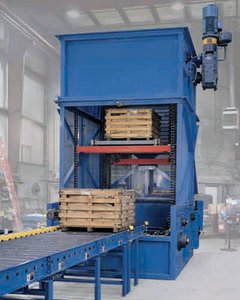Conveyor System Elevation Change What Should You Use?

Changing elevations on a conveying system is a common occurrence. The first thing to consider when deciding how to accompish the elevation change is to look at the product being handled. The length to height ratio of the product and the distribution of weight of the product will determine the angle of incline that can be used. Certain products such as pallets or alliances would require such a shallow grade that belt conveyors will not be practical. With other products that have a favorable length ratio, a belt conveyor may be the most economical means of conveyance. In general, a belt conveyor will convey at an angle, generally below 30 degrees for unit handling application, and will therefore take up more space than a vertical type of conveyor. The value of floor space should be considered when evaluating the economics of a belt conveyor.
If a belt conveyor is not suited for the application, there are several types of vertical conveyors that can be utilized. At this point, the next critical item to consider is rate of handling. For heavy loads, Vertical Reciprocating Conveyors(VRCs) are generally, the most economical and versatile. A VRC is essentially a conveyor that moves up and down like an elevator. The name comes from the up and down reciprocal motion of the conveyor. Usually, the VRC requires an up, and a down motion to deliver one load. Consequently, the conveyor is limited in terms of throughput. Because many types of conveyor beds can be used in a VRC, it will allow various flow patterns. It can convey to multiple levels, which makes it versatile.
For higher flow rates, a spiral conveyor may be considered. For relatively light handling with small package sizes, the spiral will handle the highest throughput of any of the vertical conveyors. Most of the manufacturers utilize plastic chains, so the overall width that can be handled is in the 27" range. Because there is no sequencing to feed the spiral, the product can be virtually touching, which allows a high flow rate. The spiral can be configured to allow for various flow patterns. There are rubber belt spirals, but in general they take up a lot of room and are quite expensive. Plastic belt spirals are typically a little more expensive and take up a more room than Continuous Vertical Conveyors. A spiral is a point A to point B type conveyor.
Continuous Vertical Conveyors (CVCs) come in several styles. There are flighted lifts which have flights connected to opposing chains that lift the product from a conveyor that is narrower than the product. The flights straddle the conveyor and lift the product from the infeeding conveyor. The product has to be near uniform in the width dimension due to the pick up arrangement. Product is usually pushed from the flights by means of a pneumatic pusher. Because of the pushing type discharge, multiple levels can be serviced by one unit, although pneumatic pushing can be viewed as a drawback, especially with fragile product. Another continuous lift is a pendant style lift which has a carrier suspended from parallel chains that move in a pattern similar to an oblong ferris wheel. Generally, the discharge conveyor allows the carrier to pass through while capturing the product. Multiple levels and flow patterns can be serviced by pivoting the discharge conveyor out of the way when that point is not the destination and in the path when it is the destination. This unit is difficult to maintain, but its flexibility make it a possible solution for multi-level picking operations in a distribution center.
The final type of continuous vertical lift is the four-strand chain style. This conveyor has platforms attached to four chains. The platform has a locking block which allows it to flex in one direction when returning and be rigid in the opposite direction when conveying product. This type of conveyor is only available in a "Z" flow and services only one (1) infeed point and one (1) discharge point. (Some manufacturers make a "C" configuration of this lift, but I have only heard maintenance horror stories about them.) This unit can handle up to forty loads a minute. It takes up less room and costs slightly less than the plastic belt spiral.
That is a brief overview of the options for vertical conveyors. I know I didn't touch on all the options. The best course of action is to call me with the specifics of your operation and I will steer you in the right direction.
Welcome to the TKF News Section!
Here you will find additional information regarding our conveyor systems along with Tradeshow appearances!
Please feel free to explore the links below to see what we've been up to!